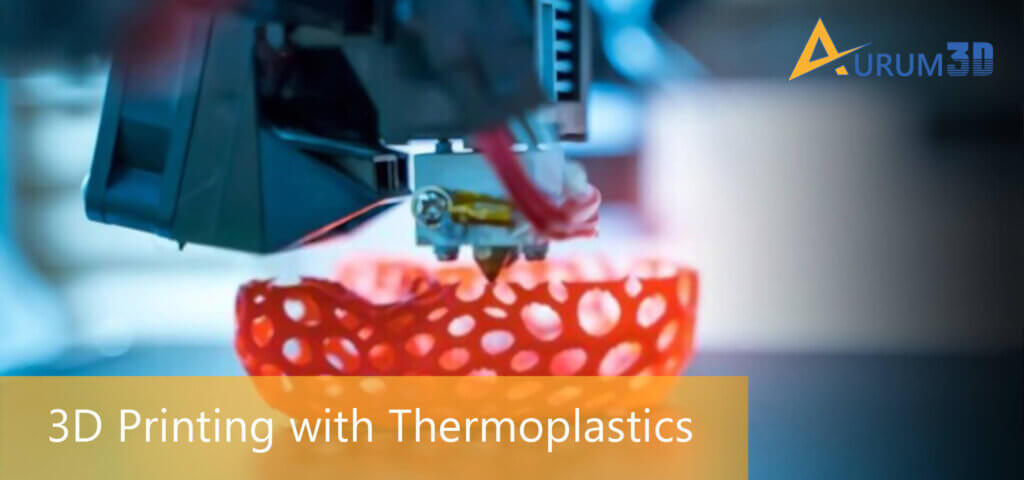While 3D-printing models, components, or prototypes the engineers have the option to choose from a variety of materials and filaments. But most engineers these days opt for thermoplastic to while 3D-printing consumer and industrial products. In addition to being more flexible than other3D printing materials, the thermoplastic or plastic polymer has the capacity to tolerate high temperature. Also, thermoplastics help engineers to obtain three-dimensional objects that require both strength and rigidity.
According to Simple English Wikipedia,
“A thermoplastic is a material, usually a plastic polymer, which becomes soft when heated and hard when cooled. Thermoplastic materials can be cooled and heated several times without any change in their chemical or mechanical properties. When thermoplastics are heated to their melting point, they melt to a liquid. They freeze to a glassy state when cooled below their glass transition temperature.”
At present, thermoplastic is one of the most preferred 3D printing material for automotive, aerospace, medical, and electronics. Thermoplastics are also used exclusively for 3D-printing specific objects or models. While 3D-printing objects, engineers have the option to choose from several forms of thermoplastics. Also, they can customize the 3D printing material simply by changing the blend or color.
Advantages of 3D Printing with Thermoplastics
While 3D-printing consumer and industrial applications, many engineers these days opt for thermoplastics as a substitute for metal additive manufacturing. They have the option to choose from several types of thermoplastics according to the nature and requirements of the application. There are a number of reasons behind the growing popularity of 3D printing with thermoplastics.
Enhanced Performance
The flexible and durable nature of thermoplastics makes it easier for engineers to extend the lifespan of the 3D-printed items. The automakers use thermoplastics to produce components that boost the performance of automotive without affecting its energy-efficiency.
Option to Reduce Weight
Unlike metal, thermoplastics help engineers to 3D-print lightweight components or objects. Despite being lightweight, the 3D-printed objects are both strong and durable. The reduce in component weight makes it easier for engineers to install and maintain the components without putting extra resources.
Minimal Material Wastage
In comparison to metal, thermoplastic helps engineers to improve material efficiency and minimize material wastage. As thermoplastic filaments melt and cure quickly, the engineers can easily create multiple versions of a component without using extra filament. Also, they can reduce material wastage by reusing the thermoplastic filaments.
Freedom to Experiment
The engineers cannot leverage 3D printing technologies to experiment with new ideas and concepts without reducing pre and post-processing time. Unlike other 3D printing materials, thermoplastics can 3D-print complex geometries without elaborate post-processing.
Different Types of Thermoplastic Used in 3D Printing
Polylactic Acid (PLA)
The widely used form of thermoplastic is created by processing plant sugar from specific crops – corn, sugarcane, and tapioca. Hence, PLA is often described as a biodegradable polymer. The environment-friendly thermoplastic melts at a temperature of 160 degree Celsius. The PLA printers are designed with small fans to keep the material cool and prevent the extruder from melting the thermoplastic. While using PLA, the 3D printing service providers do not use a heated build plate.
Acrylonitrile Butadiene Styrene (ABS)
ABS is a form of thermoplastic that can be controlled by the engineers throughout the 3D printing process. It melts at a temperature level higher than PLA. Also, the filament passes through the extruder without causing more friction. At present, ABS is used widely by 3D printing service providers for producing a variety of industrial applications. Also, it is commonly used for 3D printing innovative toys for children. Here is an interesting read on 3D printing in ABS.
Polyamides (Nylon)
The new-age thermoplastic filament is used widely by 3D printing service providers to create flexible objects that require strong bonding between various layers. In addition to supporting optimal layer adhesion, nylon filament melts at 240 to 270 degrees temperature. The printer also has the option to keep the 3D printing material transparent or add a variety of colors and dyes. At present, nylon filament is used widely for 3D-printing cups, vases, and similar flexible vessels. Its capacity to resist acetone makes this form of thermoplastic effective in producing objects that last longer by resisting acetone.
Polycarbonate (PC)
This form of thermoplastic is effective in resisting both impact and scratches. The property makes polycarbonate materials best suited to produce CDs and DVDs. Many engineers these days opt for polycarbonate materials while 3D-printing components for automotive and aerospace. However, the engineers do not opt for polycarbonate while 3D-printing bulletproof glass due to the microscopic voids created between layers. Also, the objects 3D-printed using polycarbonate become brittle and opaque after regular exposure to ultraviolet light.
Polyvinyl Alcohol (PVA)
PVA has been gaining popularity as a biodegradable 3D printing material. The water-soluble filament melts at a temperature ranging from 180 to 200 degrees Celsius. As it dissolves in the water fully, engineers opt for PVA as a support material while using other thermoplastics in 3D printing. Many engineers opt for specific forms of PVA to produce electric circuits due to their conductive properties.
High-Impact Polystyrene (HIPS)
HIPS is used widely for producing food containers and packing materials. Like PVA, HIPS is being used as a soluble support material for other thermoplastics in 3D printing. HIPS comes with the properties of ABS. But HIPS can be dissolved easily using a solvent created from the citrus plant – limonene. At present, engineers have been experimenting with the new-age thermoplastic filament by using it as a support material.
High-Density Polyethylene (HDPE)
HDPE is a form of thermoplastic which is commonly used for making bottles and similar recyclable items. HDPE binds seamlessly to itself. But it does not bind with other forms of thermoplastic seamlessly. So engineers often prefer other forms of thermoplastic to HDPE while 3D-printing items. At present, HDPE sheets are used by many engineers as a substitute to build plates.
Its strength and flexibility make thermoplastic one of the most preferred 3D printing materials. Engineers leverage 3D printing with thermoplastic to product consumer and industrial products that require strength, stability, and rigidity. The engineers also have the option to choose from several forms of thermoplastics according to the nature and needs of specific objects or products.
About Aurum3D
We, have been providing best in class FDM 3D printing services to our customers across the globe. Get in touch with our solution consultants for your custom 3D printing needs.

